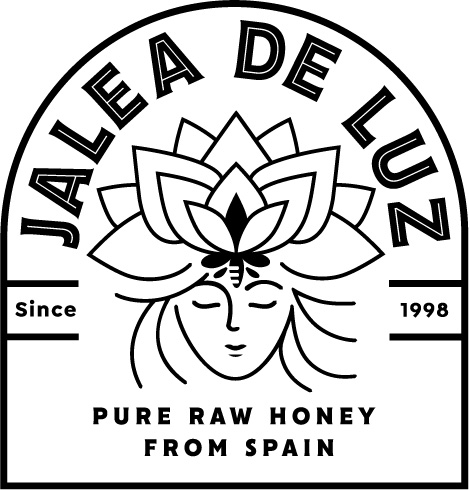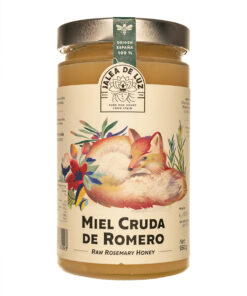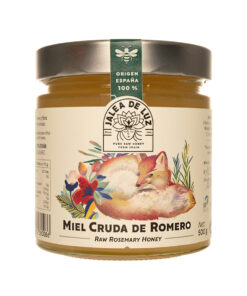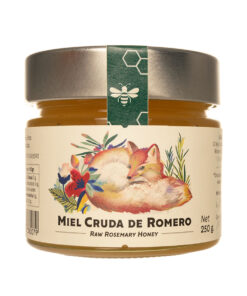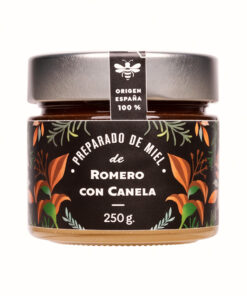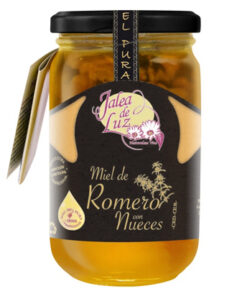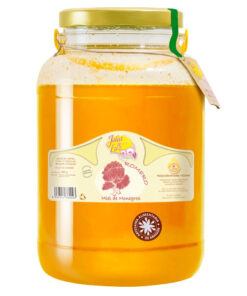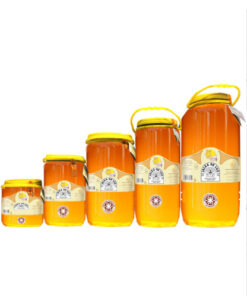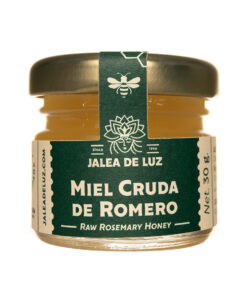Rosemary Honey
Origin: Spain and other areas of the Iberian Peninsula.Representative species: Rosemary (Rosmarinus officinalis).
Main floral composition: Rosemary (Rosmarinus officinalis) and varied monegrine wild flora.
Production time: early spring.
Color: White/amber.
Taste: Exquisite soft and delicate sweet taste.
Aroma: Floral, soft and delicate.
Peculiarities: raw honey, pure, not homogenized, not filtered, without added sugars.
Conservation: keep in a dry, semi-dark and cool place.
** In its natural process, honey crystallizes and hardens according to various parameters (temperature, floral origin, etc..).
Characteristics of Rosemary Honey
Natural pure honey of vivid color, variable texture (from fluid /creamy to lumpy by rapid crystallization) and delicate sweet anacarate flavor that provides Rosemary, as a more representative native variety that challenges the rigors of the steppe, uniquely characterizing the monegrine landscape. It has a soft and delicate aroma extremely floral.Rosemary Honeys have a high amount of essential oils (camphor, pinene, limonene, cineol, ..), flavonoids, tannins, phenolic acids, resins and other natural components from pollen and nectar collected by bees.
Usage tips
Natural Rosemary Honeys have unique qualities, being advisable to take them directly, tasting them inside the mouth as long as possible before ingesting them. To make it more manageable in those cases that are preferred diluted, it is recommended at most, warm the "bain-marie" to temperature that never exceeds 40 º to avoid the loss of attributes.Conservation tips
Keep in a dry, semi-dark and cool place to keep intact in a natural way all its essential qualities.Excellencies of Rosemary Honey
Excelsa natural honey of pure Rosemary collected by a strictly careful and environmentally friendly artisan process, in order to maintain the vital essence of a totally natural product:* Raw: has not been subjected to processes of overheating (more than 40 º) or pasteurization, preserving unchanged all vitamins, nutrients and enzymes, as well as their valuable taste and olfactory qualities •
• Pure: produced by bees through the process of pre-libation of pollen and nectar, floral, and secretions of plants and sucking insects, proceeding to subsequent processing and storage in the cells of the hive; it is for this reason that the process is 100% natural and authentic, not intervening factors beyond those that nature gives.
• No added sugars: our honey is what it is, pure, natural, raw, just as the bee collects, transforms and stores it in the hive, thus hoarding natural sugars inherent in unaltered natural honey.
* Not homogenized: we never mix honeydew from different geographical or floral origins, in order to preserve its essence and purity from the origin to the palate of the final consumer. * Unfiltered: it is never filtered, thus maintaining all the original natural qualities, obtaining an excellent unique and peculiar natural product.
Rosemary Honey, where does it come from?
Natural Rosemary Honey is produced as a result of libation to extract pollen and nectar from bees, in the flowers of rosemary plants (Rosmarinus officinalis) and varied native monegrine flora.Rosemary as a species representative of the area, is an eminently Mediterranean evergreen shrub, with a very branched and Woody appearance, whose leaves of dark green by the beam and niveas by the underside are elongated, small and numerous; its aromatic flowers have color between violet blue and whitish pink especially attractive to the Bee, finally giving rise to a brown ovoid fruit.
Rosemary Honey, Etymology and History
The word Rosemary (Rosmarinus officinallis) comes from the ancient Latin "Ros-marinus" which means sea dew, being located relatively close to coastal areas. It is also linked in some cases to a certain Greek origin, whose meaning is: "Rhops= shrub" and "Myrino= aromatic".Already in ancient Greece Greek students used it well ingested, well superimposed on their heads in the form of a crown. Also Roman civilization perpetuated its use, being usual the use of romero to prepare offerings to their deities and in rituals of spiritual purification of homes.
In the case of christianity, it is alleged that the bluish-white color of the natural flowers of rosemary is due to a legend that tells the story of the flight of the Virgin Mary to Egypt to save the child Jesus, depositing his body on a bed of flowers níveas, such that by incorporating it had become blue.
During the Middle Ages, large amounts of rosemary plant were used for its natural qualities, giving its name to pilgrims, being widely used by these along the hard way.
Restorative recipes with Rosemary Honey
- mix until the mixture acquires a consistent texture, the following foods: 1 natural soy yogurt with 2 lightly roasted and chopped peeled walnuts, a pinch of Ceylon cinnamon, a pinch of royal jelly, half a small tablespoon of eucalyptus honey and 1 tablespoon of raw Rosemary Honey dessert. Take these products in cold.
- spread a toast of spelt bread with extra virgin olive oil, half peeled tomato, then providing half a tablespoon of soy lecithin, half a tablespoon of natural Rosemary Honey and half a teaspoon of natural bee pollen. If the honey is very crystallized, it can be slightly heated to the "bain-marie" just the right amount to use
